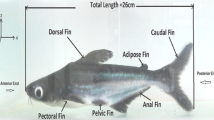Abstract
The effect of flow turbulence on the swimming speed was studied in perch (Perca fluviatilis) with different body length. The critical flow rate was used as an index of fish swimming performance. The longer was the fish, the higher turbulence was required to decrease the critical flow rate. The mechanism of turbulence impact on fish locomotion relied on the vortex structure of the flow. The torque produced by hydrodynamic forces in a vortex favors fish overturn and loss of balance. Such effect of turbulence was observed when the sizes of the vortex and fish body were similar. The fish uses the pectoral fins to restore the balance, which increases their hydraulic resistance and, together with energy expenditure for spatial balance control, decreases the swimming speed.
Similar content being viewed by others
REFERENCES
Arnold, G.H., The Orientation of Plaice Larvae (Pleuronectes platessa) in Water Current, J. Exp. Biol., 1969, vol. 50, no.3, pp. 785–801.
Dower, J.F., Miller, T.J., and Leggett, W.C., The Role of Microscale Turbulence in the Feeding Ecology of Larval Fish, Adv. Marine Biol., 1997, vol. 30, pp. 170–220.
Grinval'd, D.I. and Nikora, V.I., Rechnaya turbulentnost' (River Turbulence), Leningrad: Gidrometizdat, 1988.
Lakin, G.F., Biometriya (Biometrics), Moscow: Vysshaya Shkola, 1990.
Landry, F., Miller, T.J., and Leggett, W.C., The Effects of Small-Scale Turbulence on the Ingestion Rate of Fathead Minnow (Pimephales promelas) Larvae, Can. J. Fish. Aquat. Sci., 1995, vol. 52, pp. 1714–1719.
Loitsyanskii, L.G., Mekhanika zhidkosti i gaza (Liquid and Gas Mechanics), Moscow: Nauka, 1987.
Lupandin, A.I. and Pavlov, D.S., Effect of Starvation on Fish Attitude to Flows with Different Turbulence, Vopr. Ikhtiol., 1996, vol. 36, no.3, pp. 416–419.
Lupandin, A.I., Pavlov, D.S., Skorobogatov, M.A., and Barekyan, A.Sh., Characteristics of Locomotion of the Roach Rutilus rutilus (L.) during Jerky Swimming in a Turbulent Flow or in Stagnant Water, Dokl. Akad. Nauk, 1999, vol. 267, no.2, pp. 282–285.
MacKenzie, B.R. and Kiorboe, T., Encounter Rates and Swimming Behavior of Pause-Travel and Cruise Larval Fish Predators in Calm and Turbulent Laboratory Environments, Limnol. Oceanogr., 1995, vol. 40, no.7, pp. 1278–1289.
MacKenzie, B.R. and Leggett, W.C., Quantifying the Contribution of Small-Scale Turbulence to the Encounter Rates between Larval Fish and Their Zooplankton Prey: Effect of Wind and Tide, Mar. Ecol. Prog., 1991, vol. 73, pp. 149–160.
MacKenzie, B.R. Miller, T.J., Cyr, S., and Leggett, W.C., Evidence for a Dome-Shaped Relationship between Turbulence and Larval Fish Ingestion Rate, Limnol. Oceanogr., 1994, vol. 39, no.8, pp. 1790–1799.
Marchuk, G.I., Metody vychislitel'noi matematiki (Methods of Computational Mathematics), Moscow: Nauka, 1989.
Pavlov, D.S., Biologicheskie osnovy upravleniya povedeniem ryb v potoke vody (Biological Basis for Management of Fish Behavior in a Water Flow), Moscow: Nauka, 1979.
Pavlov, D.S. and Lupandin, A.I., Fish Responses to Flows with Different Turbulence, Dokl. Akad. Nauk, 1994, vol. 339, no.3, pp. 427–430.
Pavlov, D.S., Skorobogatov, M.A., and Shtaf, L.G., Effect of Tubulence Degree on the Critical Flow Rate for Fishes, Dokl. Akad. Nauk SSSR, 1982, vol. 267, no.4, pp. 1019–1021.
Pavlov, D.S., Lupandin, A.I., and Skorobogatov, M.A., Effect of Tubulence Degree on the Critical Flow Rate for gudgeon (Gobio gobio), Dokl. Akad. Nauk, 1994, vol. 336, no.1, pp. 138–141.
Pavlov, D.S., Lupandin, A.I., and Skorobogatov, M.A., The Effects of Flow Turbulence on the Behavior and Distribution of Fish, J. Ichthyol., 2000, vol. 40,suppl. 2, pp. 232–261.
Skorobogatov, M.A., Pavlov, D.S., and Lupandin, A.I., Effect of Current Velocity and Turbulence Intensity on the Distribution of the Roach rutilus in a Water Stream, Vopr. Ikhtiol., 1996, vol. 36, no.5, pp. 687–692.
Shtaf, L.G., Pavlov, D.S., Skorobogatov, M.A., and Barekyan, A.Sh., Effect of Flow Tubulence Degree on Fish Behavior, Vopr. Ikhtiol., 1983, vol. 23, no.2, pp. 307–317.
Author information
Authors and Affiliations
Additional information
__________
Translated from Izvestiya Akademii Nauk, Seriya Biologicheskaya, No. 5, 2005, pp. 558–565.
Original Russian Text Copyright © 2005 by Lupandin.
Rights and permissions
About this article
Cite this article
Lupandin, A.I. Effect of Flow Turbulence on Swimming Speed of Fish. Biol Bull Russ Acad Sci 32, 461–466 (2005). https://doi.org/10.1007/s10525-005-0125-z
Received:
Issue Date:
DOI: https://doi.org/10.1007/s10525-005-0125-z




